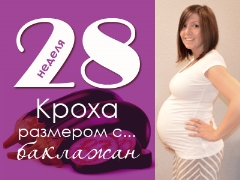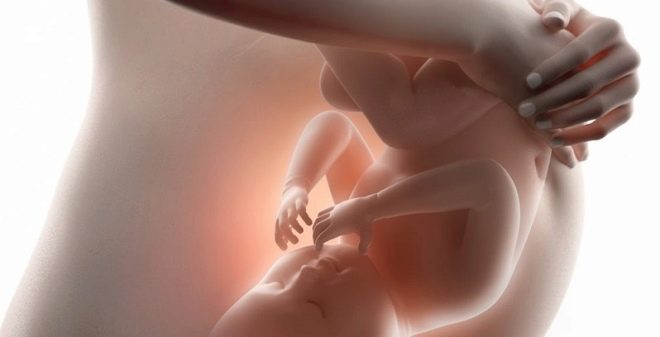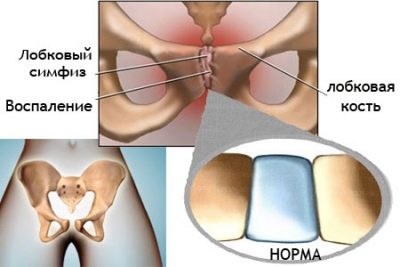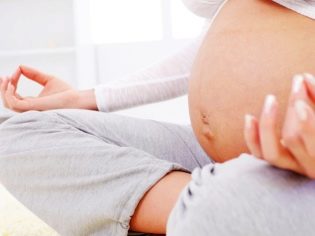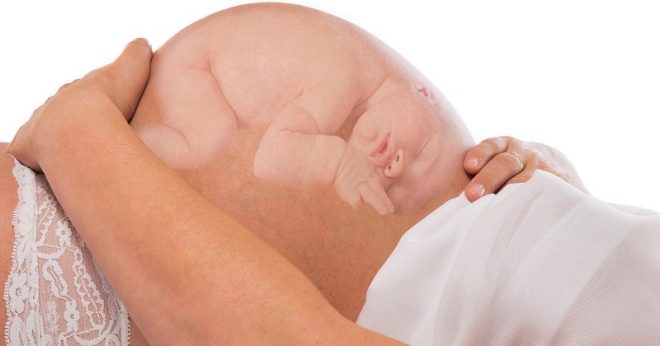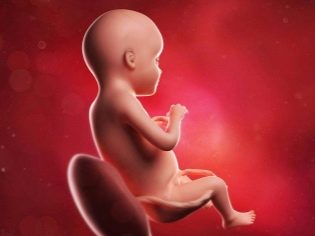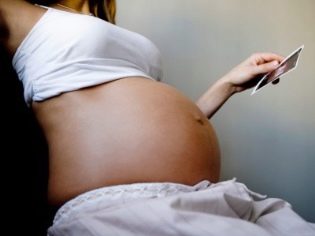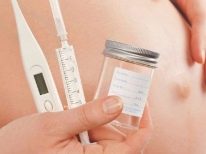28 week of pregnancy: what happens to the fetus and the expectant mother?
The third trimester beginswhat a woman can be congratulated. 28 week of pregnancy is considered one of the most important for the entire period of gestation. This is a good time to take stock of some of the first two steps and start planning birth. How is the baby and what his mother feels in the current term, we consider in more detail.
How many months is it
28 week of pregnancy - the beginning of the third trimester. According to the calendar, it took six and a half months. But during pregnancy, it is customary to count down the time according to the rule of Negale - lunar months, in each of them exactly four weeks and not a day more. By obstetric standards, a woman is now exactly 7 months of pregnancy.
Twenty six weeks went from conception, and 24 weeks have passed since the beginning of the monthly delay. A woman now may seem that all these events were very recent. Time in the first two trimesters really flew much faster. Now the state of health is changing, it is no longer so cloudless, and the expectant mother can feel that time is now slower.
Only 12 weeks remain until the cherished date of the intended delivery. However, it is not necessary to tune in to it, only 5% of babies are born in the DA. The others choose other terms for themselves - either earlier or later the DA. If a woman has a planned cesarean section, his date has not yet been determined at all, but it will be approximately 38-39 weeks or a little earlier.
At 27-28 obstetric week, which we are talking about, a variety of changes take place with the baby and the mother.
Feelings of the future mother
Increasingly, a woman wants to lie down and relax, it is becoming more and more difficult to stand, to sit for a long time, to walk. The future mother began to get tired quickly, and this is quite natural: it becomes very difficult to carry an older baby and your own increased weight.
The figure of the woman is rounded, and now there is no even a hint of the waist line, and the hips and hips are wider. At week 28, a woman can pay attention to the fact that she has deposited "fat" on the hips and abdomen. This is not a consequence of overeating, but a normal physiological process.
Such body fat is provided by nature in order to protect the fetus, as well as provide it with energy in case the mom's food suddenly disappears completely (in nature it happens).
Increased fatigue makes it very difficult to work and study at this time. Pregnant women with one baby begin to envy those who bear twins or triplets in a kind way - such moms go on maternity leave in the coming days, while everyone else will have to wait up to 30 weeks.
Very much helps the opportunity to take regular leave, if the woman in it has not been before maternity. The law does not prohibit this. And female students can apply for academic leave or arrange home schooling with the obligation to pass all exams and tests in person.
Fetal movements and counting methods
At week 28, many pregnant women notice that the movements of the fetus have become somewhat "quieter" and less. In the uterus, there is still enough space for movement, and the baby is not so large as to occupy the entire intrauterine space. The reason for the temporary "decline" is not in the parameters of the baby, but in the next stage of the formation of his nervous system - now the baby controls his movements better, and the spontaneous strokes of the arms and legs that mom feels like tremors and pintoes become smaller.
The baby in 7 months as a whole is quite regularly moving. Already this week a woman may receive recommendations from the doctor to start a diary and record the number of fetal movements in it. There are several methods for counting them, but in each, not a separate movement is accepted as a movement, but a series of movements. Example: the baby pushed his mother with his foot and turned over - these are not two different movements, but one.
Methods of Pearson, Cardiff, Sadowski test - the most common. One of them can be chosen by the attending physician as necessary.
The movements of Cardiff - this is the counting of the movements of twelve hours. As soon as a woman counts 10 episodes of baby's activity, you can stop counting further - everything is in order with the baby. If in 12 hours a dozen movements are not recruited, you should definitely consult a doctor.
The Sadowski test is the definition of a baby’s motor activity after a mom's meal. If an hour after a meal a woman manages to fix 4 episodes of baby movements and more, there is absolutely nothing to worry about.
If the movements are too active (more than 15 episodes per hour) or sluggish (less than 4 per hour after a meal), you should definitely go to an appointment with your doctor to find out the reasons for this behavior of the crumbs.
The most popular and common is the method of counting perturbation percussion. A special table is given to the woman, in which she should record the time of stirring from 9 am to 9 pm or from 8 am to 8 pm.
Diagnostic value has a time interval between 1 and 10 perturbation. If less than half an hour has passed - the result is good, if it is about an hour or more, you should consult with your doctor.
Counting perturbations is needed not so much by the doctor, because he has in his arsenal a lot of more accurate ways to figure out the nuances of the condition of the fetus, as the very future mother. This gives her more peace of mind, because she learns to control the state of her baby on her own and pay attention to possible changes in his behavior. But at each scheduled admission, the doctor will definitely be interested in how many movements there are and what they are.
In general, the character of the movements at the 28th week becomes more pronounced, that is, the crumb is already beating the crumb with its legs and arms, sometimes causing pain to its future parent. Most pregnant women manage to establish close contact with their baby this week - the baby begins to react to the touch of the mother’s hand on the stomach, stroking, and the mother knows what she wants and what she is doing at the moment.
However, it is not necessary to assume that the baby will enthusiastically respond with a kickskin to someone’s other hand on his stomach. It’s hard to say how a baby defines its own and others, but in fact this is exactly what happens. When you touch the stomach of a stranger, the crumb cautiously subsides.
Most kids even “do not trust” their own dads. If a man shows perseverance, will often talk with a crumb, applied to the spouse's stomach with his hands and cheek, the baby will surely reciprocate.
Your child at obstetric week is very meteosensitive, and also very dependent on the state and well-being of your mother. When the weather changes, its physical activity changes. If a woman is happy, the crumb behaves more actively compared to the moments of her mother's sadness. In response to a delicious dinner or dinner eaten by mom, the baby in the womb is revived.Already the temperament of the child is quite obvious: he is agile and joyful “restless” or calm and calm “sleepy.”
Pain sensations
By week 28, a rare pregnant woman can boast of a complete lack of pain. Most of the future mummies already, as a rule, have a large stock of complaints and ailments.
7 months of pregnancy - a solid period, during this period the female body begins to experience overload.
Various pains in the lower back and back are most common in this period. The loin hurts and "aches" mainly due to the fact that the center of gravity has shifted, and it is rather difficult for muscles to keep a woman in balance. The uterus grows, and together with it the ligaments holding it are stretched. This causes a variety of pulling sensations on the sides of the abdomen, lower back and sacral area.
Harsh shooting-ups, which women often compare with electric shocks, occur when a large uterus squeezes certain nerve endings. The back hurts not only because of the large abdomen and stretching of the ligaments, but also because the chest has become a couple of sizes larger, and the load on the back muscles has increased accordingly.
From week 28, the ribs may begin to hurt. The uterus presses the diaphragm, the internal organs have to "move", the costal arches slightly "diverge", which causes a tangible ache. Increasingly, a woman experiences fatigue in her legs, her joints can ache, or varicose veins can manifest themselves - all these are consequences of an increase in the body weight of a pregnant woman. Weight grows faster than the body has time to compensate for this. Knee joints and ankles are especially vulnerable.
More than half of pregnant women have a pubic bone at week 28. You do not need to be afraid - this pain suggests that the body began to actively prepare for childbirth. The hormone relaxin is produced, which softens and makes the pelvic bones more elastic. At the right moment they should move apart and let the baby out. The process of softening of bones and ligaments is accompanied by weakness and small "lumbago" in the pubic joint.
If the pain becomes unbearable, the woman cannot walk, stand, climb stairs, it is difficult for her to sleep because of the pain that is worse at night, you should definitely inform your doctor about it - it is possible that symphysitis develops - a pathological divergence of the pubic symphysis, in which quite often a woman is shown only childbirth by caesarean section.
A woman at week 28 should know that any pain that is accompanied by discharge from the genitals other than normal, increasing, cramping or cutting pain are reasons to call an ambulance, because preterm birth is quite possible at this time.
Nature of discharge
In a woman, with the onset of the third trimester, estrogen production increases. Because of this, discharge at 28 weeks may become more fluid than they were before. The amount of discharge remains quite abundant, vaginal secretions are produced a lot. This is necessary so that the composition of the microflora of the vagina is maintained at the level that will provide the “correct” cut in the genital tract.
Liquid discharge should not be confused with watery. If a woman now has abundant watery discharge, be sure to notify the doctor to make sure that the water does not drain and does not leak.
For the 28th week, discharge is considered to be light, slightly watery, homogeneous, without impurities or an unpleasant odor. The normal variant is a light yellowish tint (a pregnancy hormone, progesterone, can give a vaginal secretion such a color). If the discharge has acquired a rich yellow color, become thick, smearing, be sure to visit the doctor and do a smear analysis.
Unpleasant greenish or gray discharge, which is accompanied by a bad smell and itching in the perineum, may indicate the presence of a bacterial infection of the genital tract, genital infection. White discharge, with flakes and concomitant itching - this is a thrush.
The most dangerous now are the discharge with blood. They can talk about the threat of premature birth, placental abruption, the beginning of preterm birth. The bleeding may have a different appearance - from pure red blood to pink, cream, brown secretions of varying intensity and consistency.
In time to notice the change will help the habit of wearing daily thin sanitary pads. They not only “show” the color and consistency of the vaginal secretions, but also help to get rid of the sensation of moisture in the perineum, which is associated with an increase in the amount of discharge that is natural for this period. Tampons cannot be used.
The mood of the future mother
At the 28th week of pregnancy, mood swings, irritability, and touchiness are not excluded. The state of health worsens, and it is directly connected with changes in mood.
Most of the women are waiting for help from friends and relatives, but the fact that they cannot get along without this help sometimes depresses and makes them feel some kind of inferiority. Thus, it is already difficult for a pregnant woman to tie her shoelaces on her own or to fasten zippers on her boots, stand at the stove or hang laundry. Raise a fallen object without kneeling, often fails.
Anxiety on decree also contributes to anxiety, because working women worry about the safety of their workplace: the expectant mother needs to be sure that she will leave after work leave and she will be expected there. To dismiss a woman who is on maternity leave or parental leave, according to the law is impossible. So now you can not worry about it.
Most of the anxiety at 28 weeks causes fear of the upcoming birth. It is not only pregnant first-born women who are afraid to give birth, and women who have given birth earlier are often far more worried because they are better aware of all the dangers and risks and are familiar with sensations and possible complications.
Psychologists do not recommend keeping silent about such fear, because there is nothing unusual or unnatural about it.
If you can’t talk about your experiences with your relatives, or the woman doesn’t feel support and understanding, you can contact a psychologist who accepts future mothers in every antenatal clinic for free.
Changes in the body
All organs and systems of the future mother are working at the limit of their capabilities. When their condition is compared with overload in space, it is not so far from the truth. The uterus grows so fast that now it is the largest organ, the rest of the "inhabitants" of the abdominal cavity have no choice but to push aside.
Uterus growth
Breathing becomes hard. Deep breaths are not easy, because now the uterus is tightly pressing the diaphragm from below. There is shortness of breath, which increases even after a little exercise. It is more difficult to climb stairs, walks, household chores.
The uterus, which was the size of a woman's fist before pregnancy, has now grown to an impressive size. The height of the standing of her day this week is 27-29 centimeters. Above the navel line, the uterus rises already by 8 centimeters.
Dyspnea is not the only problem caused by such an increase. Heartburn and belching - a consequence of compression of the stomach, diarrhea and gas formation associated with pressure on the gallbladder and impaired outflow of bile, constipation - a consequence of the pressure of the uterus on the intestinal loops. Frequent urination is the scourge of all pregnant women, because the bladder is squeezed by the uterus one of the first.
The length of the cervix in the norm is 35-45 mm, a small shortening is not considered a pathology, especially in multiple or repeated pregnancies. But shortening less than 35 mm is considered a threat to preterm delivery.
The kid is already quite heavy, he significantly weighs on the neck from the inside. A healthy wealthy cervix can withstand this pressure up to 38-40 weeks of pregnancy. With isthmic-cervical insufficiency, the risk of premature birth of the baby due to the fact that the cervix simply cannot hold it in the uterus is ten times higher.
The uterus can more often than before, come to tone. If this happens too often, the woman is given treatment. "Ginipral" helps to relax the uterine muscles, "Papaverine», «No-shpa».
At week 28, wearing an antenatal orthopedic brace will be beneficial. This device allows you to ease the load on the lower back, legs and back, which will manifest a decrease in discomfort.
Weight gain
Weight gain at week 28 is intense and delivers not the most pleasant feelings to the future mother. The woman is already noticeably “heavier”, but this is caused not only by her own weight, but also by the weight of the child, who is now over a kilogram, the weight of the placenta, which is already approaching 400 grams. Amniotic fluid - about a liter, and the uterus itself now weighs about 600 grams. The amount of blood in the body of a pregnant woman has increased, and this is also reflected in weight.
The weekly increase in this period should not exceed 400 grams. If we estimate the total increase for the entire period of carrying a baby, then it is already solid - more than 9 kilograms.
- Thin girls can gain by this week already 10 kilograms.
- The fair sex with a normal weight is about 9 kilograms.
- Women who had problems with excess weight before conception should not gain more than 6 kilograms.
Women often pay attention to the fact that different doctors use different charts of weight gain. One doctor, at 8 kilograms, will say at week 28 that this is an excellent result and everything is fine, while another will suggest a diet for weight loss. You need to focus only on the standards of the doctor who observes your pregnancy, without comparing your gain with others.
A strong lag in weight gain can alert the doctor, because it can speak about pathologies of the placenta, intrauterine growth retardation of the baby. Brute force is also dangerous - the incidence of complications in labor in women with a pathological weight is higher than that of those who scored less.
Also, excess body weight may be a sign of the presence of internal edema - preeclampsia.
Training bouts
Braxton-Hicks contractions at 28 weeks, according to available statistics, experience about 50% of women. Basically, those who are going to give birth to their first child. For women who are carrying their second, third or next child, false contractions usually appear closer to childbirth, sometimes several days or even hours before them. There are women who have no false contractions at all. For example, pregnant women again after the first pregnancy ended in caesarean section, very rarely encounter such a phenomenon as false contractions.
The true nature of Braxton-Hicks contractions to physicians and scientists today is not entirely clear. A common version of what is happening explains their preparatory "work" uterine muscles.
A woman feels such contractions infrequently. They are manifested by a small tension of the abdomen, the woman feels for a few seconds or minutes that the uterus becomes “stone”. If you lie down and relax, the smooth muscles of the uterus relax again.
This is the main difference between false fights and real ones. If childbirth begins, the contractions can no longer be allayed. Neither rest nor warm shower will help.
Other changes
Blood pressure rises, and at week 28 it comes to a level that was natural for this woman before pregnancy. But future mothers who are prone to increased pressure, may begin to suffer from hypertension.Therefore, now, more than ever, it is important to monitor blood pressure, daily measuring its level on two hands.
The skin of the pregnant woman becomes drier, in some places there are areas with increased pigmentation. Moles and freckles become brighter. Now you should not sunbathe, because sensitivity to ultraviolet grows dozens of times.
Itching in the thighs, chest and abdomen may occur: this is a consequence of stretching the skin. The formation of "stretch marks" is also a fairly frequent phenomenon associated with a gap in the stretched areas of the skin of elastin and collagen fibers.
The blood level increases cholesterol. And this is the very rare case when such a phenomenon is considered the norm. This substance is necessary for the placenta so that it can cope with its hormone-generating function.
Sweat glands continue to deliver a lot of hygienic and aesthetic inconveniences: sweating is increased, the woman often throws "in the heat." The breast swells, the amount of colostrum increases.
In this period, a woman is most susceptible to allergies - contact and food. This is due to a temporary decrease in immunity. And even those women who previously had no allergic manifestations, may begin to suffer from itching and an unusual rash, cough and runny nose after using cosmetics from stretch marks, after imported strawberries bought in January, after taking the most common multivitamins.
Baby development
New organs and systems at week 28 (corresponding to embryonic week 26) are not formed. Everything is already formed and is preparing for the fact that soon the baby will begin to exist separately from the mother. The prenatal period has ended, the 28th week of the perinatal stage or the birth-related begins. Now the main task of your baby is to grow and strengthen, by the time of birth he needs to accumulate a lot.
The growth of the baby this week increased slightly compared with the previous week - only 1 centimeter. Now he is about 36-37 centimeters.
The weight of the fetus increases more significantly: at week 28 it is on average in the range from 1,300 to 1,400 grams. There is already a difference in weight between children of different sexes. So, girls at week 28 are lighter than boys by about 150-200 grams.
The vast majority of babies have already taken a head down position in the uterus. Headache presentation is considered the most suitable for birth. If your baby is still sitting on the pope (pelvic presentation) or lying across (transverse presentation is quite rare), there is still a chance that the situation will change to a headache.
In the uterus there is still free space for the baby to turn over. A woman is recommended for this special gymnastics and standing in the knee-elbow position. It helps a lot.
Appearance
Baby is becoming more cute. At week 28, his eyelashes are lengthened, cute plump cheeks appear. The nails on the hands and feet begin to grow more actively - until their length reaches the tips of the fingers, therefore the crumb does not scratch itself. Eyes until all babies have a sky-blue color, a little later, the iris will begin to change.
The tummy has grown, hands and legs have a little recovered. Due to the fact that in recent weeks the baby has been actively increasing subcutaneous fat, he no longer looks as thin as before, but he still does not look like a newborn cutie with an advertising booklet.
Compared with a full-term baby, he is very thin. But the skin has ceased to be bright red, mauve, blood vessels are no longer visible through the skin. The skin has become four-layered.
The accumulation of subcutaneous fatty tissue is one of the most important processes at this time, because how much it is formed depends on how much the baby can keep warm after its birth. While fat deposits prevail on the cheeks, lower back, neck. The deposition of subcutaneous tissue begins in the area of the buttocks. Soon there will be a pretty plump ass.
The child looks quite proportional.Head, body, limbs - everything is in visual “balance”. A week earlier, the baby began to take a natural "flexion" pose. It ceases to fit in the uterus in a straightened state, it becomes crowded.
Now, due to the fact that the crumb presses the legs, it may be difficult to diagnose the sex of the baby on ultrasound. If earlier it was not possible to find out the floor, now the accuracy of determination is low: the genitals are closed with legs, umbilical cord, handles.
All the features of the face of the baby are fully formed. The eyes still seem large, but this is due to some thinness. As the weight gains, this visual "deception" will disappear.
Ears slightly bulged: cartilage tissue does not harden immediately, it takes time. The eyebrows, which a couple of weeks ago were reminiscent of Brezhnev — heavy and large, diminish, cease to “hang” above the sockets.
On the body of the baby there is a layer of cheese-like lubricant that protects the skin, which has not yet completed the formation of all its protective functions. The lubricant fixes and holds a layer of virgin lanugo hair. They appeared almost immediately, as soon as the hair follicles were formed, and at the 28th week the baby begins to get rid of them.
The skin is becoming more perfect, lubrication remains a need only in the folds, where friction is possible, and in vulnerable places - the groin, in the folds on the arms and legs, neck folds. Closer to the birth lubrication will remain mainly there. In Lanugo, too, almost no need. The hairs fall out. By this week, the baby gets rid of about a tenth of the hairline.
Nervous system
The movements of the baby are already reminiscent of the movements of a newborn baby. To achieve this, the nervous system had to “work” properly, and its formation was not yet completed. The kid has several important reflexes for survival - sucking, swallowing and grasping. This is only the "tip of the iceberg." In addition to them, muscle and tendon reflexes, tonic and cervical, are already found in the baby.
Specialists also refer to the reflexes respiratory movements, which are now perfectly visible on ultrasound. Baby makes them irregularly. Doctors believe that this way the baby improves its blood circulation, as during such movements the pressure inside the abdominal cavity decreases and the blood flow to the vena cava increases. Also, the respiratory movements at week 28 actively prepare the lungs and bronchi for future independent breathing.
All major divisions of the central and peripheral nervous systems are formed. The most intense development of the brain. Now it has centers that will later be responsible for thinking, analytical skills, speech perception, and images. The functional component of the thermoregulation center is laid.
New neurons are formed in huge quantities every hour. They are building new neural and neuromuscular connections, connecting the muscles with the brain, so the crumb is already quite good for his age to control movements with his hands and head.
The brain is now interconnected with the adrenal cortex, the child has its own hormonal background, and growth hormones are among the first to begin to be synthesized.
The baby one of the hemispheres already prevails over the other. If he more often prefers to suck the cam of the right hand, he is already right-handed, if his left is left-handed. In rare cases, ambidexters are born - people who equally well own both right and left hands.
The brain is already receiving signals from the senses. The baby listens and hears how the mother's body sounds from the inside, he especially likes her voice and the sound of her heart.
External sounds are heard to him with difficulty: interfere with a thick abdominal wall, placenta, amniotic fluid. But something tiny can hear - loud claps, calls, loud voices, music. The kid becomes less fearful than a week earlier, he gradually gets used to the sounds from the outside.
The optic nerve begins to send the first images to the brain. While it is colored spots of different sizes.But now the baby "understands" the danger of bright light: the corresponding reflex causes him to close his eyes if a strong beam of light is directed at the pregnant belly.
The sense of smell is almost formed, the touch of a baby has been mastered quite a long time ago. From week 28, it becomes more discriminating in the “food” - taste buds are improved. Now the baby has subtle nuances of tastes.
Sleeping baby about 21-22 hours a day. He is dreaming, because he already has a fast sleep phase fixed in hardware. The baby is very sensitive to mother's emotions and experiences, so now it is very important to protect the future mother from stress and shocks.
The development of internal organs
All the internal organs of the baby are working normally. They are formed and now only increase in size. Digestion is established: the baby drinks amniotic fluid, lanugo and epithelial cells, which are present in it, are not digested and are sent directly to the intestine, where, mixing with bile, they become the basis of the original feces meconium.
Empty baby intestines after birth. In some cases, intrauterine defecation occurs. It is usually associated with severe hypoxia of the fetus, and meconium in waters is the basis for early delivery.
The baby's heart pumps more than 20 liters of blood per day, it works “like a clock,” 140-169 beats per minute is considered the norm of the heartbeat at the 28th week of pregnancy. All blood vessels are fully formed.. The baby produces all the structural blood cells. The kidneys are busy producing urine, the baby pees once an hour or a little less.
The most global processes this week occur in the respiratory system of the baby. In the lungs, the formation of alveoli - small vesicles - direct participants in gas exchange is completed. To prevent their walls from sticking together after the first expiration, a special substance is needed - surfactant. Its production is now engaged in immature alveoli.
The more the crumb accumulates surfactant at the time of its birth, the greater the chance of its survival. A common cause of death in premature babies is acute respiratory failure, which develops due to the small amount of surfactant.
Viability
Seven-month children survive very well in the event of their premature birth. Everyone knows about it, even people far from medicine. If childbirth occurs at the 28th week, the baby will be considered exactly seven months old. About 95% of babies are viable at this time.
According to the medical classification of prematurity, they are considered to be deeply premature, and for a certain time they will need a special incubator. In it, the child will “ripen”, receive oxygen and be heated, since the amount of subcutaneous tissue that the child has accumulated by the 28th week is not enough for the body to retain heat.
In the incubator, the baby will have to spend as much time as it takes to gain 700 kilograms in weight of 1 kilogram. Then the baby will be transferred to a cot with heating, and when his weight exceeds 2 kilograms, the child and his mother will go home.
Those born at the 28th week of pregnancy have not only high chances of survival, but also slightly reduced risks for the development of pathologies of the nervous system, although this option cannot be completely excluded: the immature nervous system can present a lot of unpleasant "surprises" that none of them can even the most experienced doctor.
Your baby on ultrasound
Referral to an ultrasound at the 28th week of gestation is issued only for special medical reasons, which include the threat of premature birth, suspicions of fetal distress, pathology of the placenta.
If a pregnant woman just wants to admire her baby, and gynecologists often joke that the best medicine for the future mother is an ultrasound, then she can do it on a paid basis in any clinic that offers such diagnostic services.
Harmful or not doing ultrasound during pregnancy is often a moot point. There are many arguments in favor of different answers to this question. Officially, the harm from ultrasound does not exist.
Opponents of the study indicate that the effects of ultrasound are not yet fully understood. Therefore, this question remains at the discretion of the pregnant woman and her family members.
If, nevertheless, at the 28th week it is planned to do an ultrasound, you should know which developmental norms of the baby are typical for the current week:
- BPR - 65-79 mm;
- LZR - 83-99 mm;
- DBK - 49-57 mm;
- DKG (shin or length of the tibia) - 45-53 mm;
- DKP (length of the bones of the shoulder) - 45-53 mm;
- Head circumference - 245-275 mm;
- Abdominal circumference - 220-280 mm.
The placenta now has a thickness of 22-37 mm, most often - 28-29 mm. The degree of her maturity this week is normal - zero. In case of premature aging of the placenta, the woman is given special treatment, which is designed to maintain the “baby seat” in a functional state for as long as possible.
Hazards and Risks
The immunity of women is greatly reduced, and it is this reason that becomes the main risk factor in the 28th week of pregnancy. At the very beginning of pregnancy, it is impossible to do without a decrease in immune protection: this mechanism is provided so that the mother’s immunity does not discard the fetus. As a result, by the middle of pregnancy, immunity decreases by about 30%, and by week 28 it becomes even weaker.
This creates a real threat of infection with influenza or ARVI, other viral and bacterial infections. Even banal colds can pursue a woman more often and flow heavier than usual. Often women in this period are faced with angina, conjunctivitis, rhinitis and bronchitis.
By themselves, these ailments for the baby are no longer as dangerous as it was at the very beginning of the gestational period. It is much more dangerous for a woman and a child to try to cure a cold or reduce fever with folk remedies or medicines, the use of which is not coordinated with the doctor.
The danger of preterm birth can trap any woman, not only pregnant women at risk of miscarriage, cervical insufficiency, etc.
To reduce the likelihood of the beginning of labor activity at such an early time for this period will help correct lifestyle and attentive attitude of women to their health and the need to comply with the recommendations.
Now you should avoid sudden movements, injuries, weight lifting and excessive physical exertion. In case of deterioration of well-being, you should immediately consult a doctor: in many cases, preterm delivery can be stopped in the hospital with the help of medicines. Under the supervision of doctors such a pregnant woman will have to stay for several weeks.
Improper diet, sedentary lifestyle and pressure of the uterus on the intestines and lower hollow veins at this time can cause hemorrhoid symptoms - itching in the anus, pain during defecation, burning, and blood during bowel movements. They do not need to be tolerated: in the third trimester, you can use a fairly wide range of drugs for this delicate disease. A specific tool may recommend a doctor.
Analyzes and surveys
At the 28th week of pregnancy, a complete examination is necessary for women who take maternity leave - expectant mothers of twins or triplets. The rest of the women, as before, are recommended only a complete blood count, which will show whether the woman has gestational diabetes and anemia, and a general urine test, according to which the doctor will evaluate the work of the kidneys of the pregnant woman and make sure that she does not have preeclampsia.
Women with a negative Rh factor are given a blood test for antibody titer this week if the study was not conducted a week ago, and if necessary, anti-Rh immunoglobulin is administered.
If a child’s condition gives rise to concerns, there is suspicion of fetal hypoxia or other impairments in its development, the first CTG (cardiotocography) may be indicated this week.
Recommendations to expectant mothers
At the 28th week of pregnancy, the diet of a woman should become more nutritious - the need for calories increases to 3200 Kcal. This does not mean that you can now eat fried and fatty.
It is recommended to increase caloric content through dairy products, vegetable salads with vegetable oil, whole-grain bread. Other recommendations relevant at this time are as follows.
- Plan your maternity leave, try to transfer all the affairs to your colleagues, do not leave unfinished business and unresolved issues. You are hospitalized with 30 weeks. You can calculate the amount of maternity payments, taking into account the income for the last two years, using special calculators.
- When going on vacation or traveling to gain strength before giving birth, be sure to check with the airline company if you need a doctor's certificate that the flight does not threaten your health. Usually such certificates require all expectant mothers from the 28th week of pregnancy.
- If you suffer from insomnia, get a special pillow for pregnant women. It allows you to comfortably accommodate a large belly, the quality of sleep will improve somewhat. Also, walk more in the fresh air, do not neglect the evening walk before bedtime.
- Start doing Kegel exercises - a set of exercises for training your pelvic muscles, which will be a good preparation for childbirth. In addition, such a gym significantly improves the quality of sex. Before classes, be sure to check with your doctor if you have any contraindications to it.
- Sex itself at week 28 is not prohibited if the pregnancy proceeds without complications and threats. But now he demands from partners a more reverent attitude to the position of a woman. Anal sex is contraindicated, postures in which pressure is applied to the abdomen, as well as postures with deep penetration.
- If the dowry of the child has not yet been prepared, this week you can go shopping. The forces for this in a pregnant woman still exist, going to the store will not turn into a continuous torment. If you postpone it for a later date, you will have to make purchases from the last forces.
- Remember that your baby feels everything. Read to him fairy tales and sing songs, watch kind films in which there are no bloody scenes and violence, listen to soft pleasant music: good taste and a sense of beauty are being formed now. Avoid scandals, screams, abuse, negativity and stress.
- Follow the rules of personal hygiene. Sweating, a large amount of discharge, reduced immunity - these are good prerequisites for the development of infectious diseases, as well as the recurrence of chronic diseases.
- Be sure to enter your quiet hour mode. One and a half hours of daytime sleep will help a woman to more easily endure all the third trimester.
Pregnant Reviews
Women, who at the 28th week decided to take another vacation before the maternity leave, note that rest on the sea, which the whole family had been waiting for, for the expectant mother is sheer torment. It is already uncomfortable in a bathing suit, you will not lie down in the sun for a long time, you want to eat all the time, but it is already difficult to go on excursions in order to distract yourself from the buffet.
Many recommend to go not to the sea, but to any resort city with good and fresh air, for example, to Pyatigorsk. Rest there will bring more benefits.
Women compare their state of being with space flight, the state of a seal, a whale. The sluggishness of many begins to annoy. Swelling and varicose veins are frequent "satellites" of this week. Among non-standard questions, most often women worry about whether it is possible now to cut and dye their hair. The hairstyle is admissible, and it is better to wait a little with hair dyeing.
About what happens to the fetus and the future mother at the 28th week of pregnancy, see the following video.
